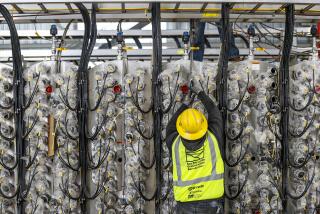New Sewer Line Brings Hope for a Cleaner Ocean : Environment: A $115-million replacement system promises to end the dumping of raw sewage into Santa Monica Bay.
COASTAL â Heal the Bay President Dorothy Green wore an especially large smile for the crowd of about 200 people gathered before her Thursday.
And she had good reason. After seven years of lobbying local wastewater authorities to raise standards for treating sewage, she was finally able to participate in the opening of a new sewer line that promises to end the dumping of raw sewage into Santa Monica Bay.
The North Outfall Replacement Sewer (NORS), which took 2 1/2 years and $115 million to build, will replace a badly deteriorated sewer built in the 1920s.
During rainstorms, the old sewer line routinely filled to the brim, forcing workers to divert raw sewage directly into the sea via Ballona Creek.
âThe primary beneficiaries of the NORS system being built are the ocean and the people who use the ocean,â said Green, whose environmental group has been fighting for more than a decade to clean up Santa Monica Bay. âThere will no longer be those raw sewage spills into the bay.â
Workers diverted the flow from the old line earlier this month, sending about 100 million gallons a day into the new line, which extends from the edge of the Crenshaw District to the Hyperion Treatment Plant in Playa del Rey. The new line has a capacity to carry 500 million gallons a day.
In a ceremony Thursday near La Cienega Boulevard and Rodeo Road, Los Angeles City Councilwoman Ruth Galanter officially opened the sewer by tossing several handfuls of rose petals and daisies into an opening through which spectators could see the rushing river of sewage.
âWe were able to replace a very old and very sad sewer system,â Galanter said. âIâm sure all of (my constituents) will be very grateful when this is done, . . . and some of those trucks go away and leave them alone.â
Jeanne Breunig, who headed the citizens committee formed to address concerns of residents, said the noise and dust were a nuisance during construction of the eight-mile underground pipe.
But the city acted sensitively and responsibly, she said. Several families in Westchester who complained of loud noise from the underground excavation, for example, were moved to local hotels at city expense.
Heal the Bay galvanized public awareness and played a major role in the approval in 1985 of a $3.4-billion plan to upgrade and expand the cityâs sprawling sewer system, said Bradley Smith, deputy engineer for the City of Los Angeles. The system serves the Westside, San Fernando Valley, Glendale and Burbank.
In 1986, the state regional water quality control board issued an emergency order requiring the city to complete the replacement pipeline by April, 1993.
The line extends from the spot near La Cienega and Rodeo to the Hyperion plant but will eventually become part of a 23-mile backbone stretching to the Los Angeles-Glendale treatment plant.
Workers will repair the old sewer line after it dries out, and it will be used as a backup for the new line.
As a result of the new projects, sewer bills across Los Angeles have been rising steadily, and cities that contract with Los Angeles for sewer services are not happy, Smith said.
Most cities pay their sewer tab out of fees collected from individual monthly sewer bills and from voter-approved bond issues designed to spread the costs out over time.
But many are demanding justification for the spiraling costs. Some cities, whether on purpose or not, are falling behind on payments. Los Angeles is suing El Segundo for not paying a single sewer bill in the past several years, Smith said. The bill now stands in excess of $2 million.
But at Thursdayâs press conference, Felicia Marcus, president of the Los Angeles Board of Public Works, drew attention to past accomplishments, such as cleaning up sludge on the ocean floor, adding that people should feel their sewer bill dollars are being used well. This latest project, especially, will allow environmentalists and drought-watchers alike to rejoice during wet wether instead of fearing the sewage spills they often bring, she said.
âNow it can rain, and we donât have to feel guilty about it,â she said.
More to Read
Sign up for Essential California
The most important California stories and recommendations in your inbox every morning.
You may occasionally receive promotional content from the Los Angeles Times.










